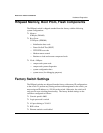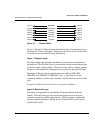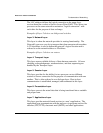
Cabling
US7070447-001, Rev 01
4-3
Draft Level—Hitachi Confidential
10/100BASE-TX Ports
The 10/100BASE-TX ports on the HiSpeed switch are standard RJ-45
connections using UTP Category 5 cabling. These ports, like the 10BASE-TX
ports, are wired for MDI-X and require a crossover cable when connecting to an
Ethernet hub or another switch.
The 10/100 Mbps ports support autonegotiation where speed is set by polling the
connected device and determining which speed, 10 Mbps or 100 Mbps, is the
most optimal.
The 10/100BASE-TX ports on the HiSpeed switch are designed to support both
half-duplex and full-duplex operation. By definition, the CSMA/CD protocol is
half-duplex. allowing either data transmission or reception, but never both at the
same time. Point-to-point network connections, such as DTE-to-switch ports,
allow a file server to transmit frames to a switch while simultaneously receiving
frames from the same switch. This two-way, non-CSMA/CD full-duplex
communication allows an effective bandwidth of 200 Mbps between two devices.
Both the port speed and the duplex mode can be set using the CLI command
ETHERNET/CONFIG/PORT
For information on these commands, refer to the HiSpeed Switch User Guide,
document number US7070424-001, that was shipped with your switch.
100BASE-FX Ports
The 100BASE-FX ports are used to attach fiber-based 100 Mbps connections to
the switch. These ports provide direct attachment to end stations, switches, or
servers where multimode fiber is installed. The 100BASE-FX ports accept
standard SC connections using 62.5/125 micron fiber optic cable. The
100BASE-FX ports function at full-duplex only (200 Mbps) and does not support
autonegotiation.
!
Note:
Since these ports are capable of operating at 100 Mbps, it is imperative
that only Category 5 cabling be used.


















